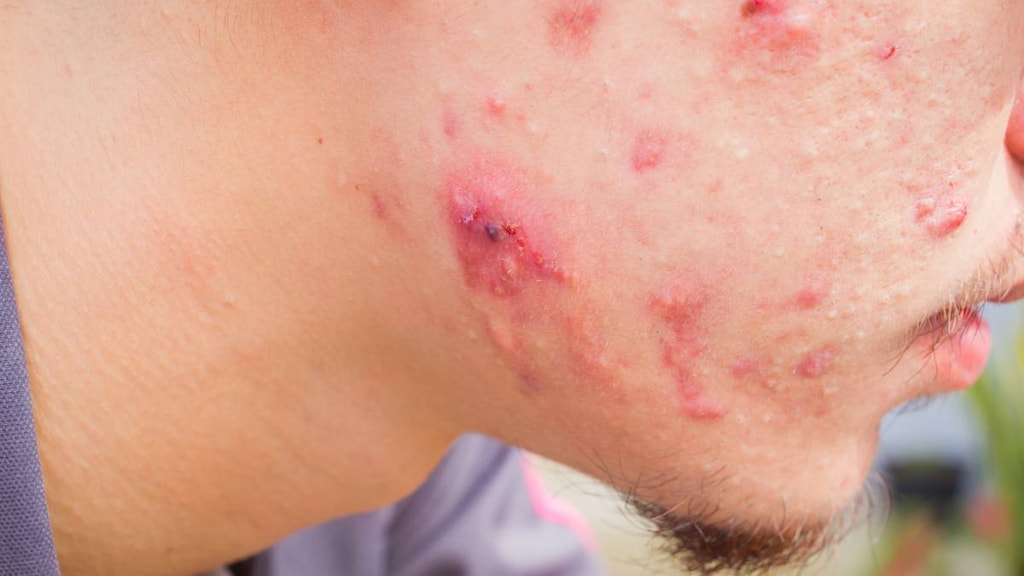Dosage Forms
Excipient information presented when available (limited, particularly for generics); consult specific product labeling. [DSC] = Discontinued product
Cream, External:
Differin: 0.1% (45 g)
Generic: 0.1% (45 g)
Gel, External:
Differin: 0.1% (15 g, 45 g); 0.3% (45 g) [contains edetate disodium, methylparaben, propylene glycol]
Differin: 0.1% (15 g, 45 g) [fragrance free, oil free; contains edetate disodium, methylparaben, propylene glycol]
Generic: 0.1% (45 g); 0.3% (45 g)
Lotion, External:
Differin: 0.1% (59 mL) [contains methylparaben, propylene glycol, propylparaben]
Generic: 0.1% (59 mL [DSC])
Pad, External:
Generic: 0.1% (14 ea)
Solution, External:
Generic: 0.1% (60 mL)
Pharmacology
Mechanism of Action
Retinoid-like compound which is a modulator of cellular differentiation, keratinization, and inflammatory processes, all of which represent important features in the pathology of acne vulgaris
Pharmacokinetics/Pharmacodynamics
Absorption
Topical: Minimal; only trace amounts have been measured in serum after chronic application
Excretion
Bile
Onset of Action
8 to 12 weeks
Half-Life Elimination
Terminal: 7 to 51 hours (gel)
Use: Labeled Indications
Acne vulgaris: Treatment of acne vulgaris.
Use: Off Label
Rosaceac
Topical adapalene for the management of rosacea has been studied in a limited number of patients, with data suggesting it may be a useful alternative to topical metronidazole in patients with papulopustular rosacea
Contraindications
Hypersensitivity to adapalene or any component of the formulation.
Lotion: There are no contraindications listed in the manufacturer's labeling.
OTC labeling: When used for self-medication, do not use on damaged skin (cuts, abrasions, eczema, sunburn).
Documentation of allergenic cross-reactivity for retinoids is limited. However, because of similarities in chemical structure and/or pharmacologic actions, the possibility of cross-sensitivity cannot be ruled out with certainty.
Canadian labeling: Additional contraindications (not in US labeling): Patients with eczema or seborrheic dermatitis; women who are pregnant or planning to become pregnant.
Dosage and Administration
Dosing: Adult
Acne vulgaris: Topical: Apply once daily in the evening before bedtime. If irritation occurs, may reduce the frequency of application.
Rosacea (off-label use): Topical: 0.1% Gel: Apply to affected area once daily in the evening for up to 12 weeks (Altinyazar 2005)
Dosing: Geriatric
Refer to adult dosing.
Dosing: Pediatric
Acne vulgaris, treatment: Children ≥7 years and Adolescents: Limited data available in ages <12 years (Eichenfield 2013): Topical: Apply once daily; cream, gel, or solution should be applied in the evening (at bedtime). Note: During the initial 2 weeks of therapy, it may appear that acne worsens; full effect may take up to 8 to 12 weeks of therapy.
Administration
For topical use only; not for oral, ophthalmic, or intravaginal use. Avoid contact with abraded, broken, eczematous, or sunburned skin, mucous membranes, eyes, lips, and angles of the nose. Moisturizers may be used if necessary; avoid alpha hydroxy or glycolic acid-containing products. A mild transitory sensation of warmth or slight stinging may occur shortly after application.
Cream/gel: Apply a thin film to clean/dry skin in the evening before bedtime; apply enough to cover entire affected area.
External pad: Remove pad from foil just prior to use. Before bedtime, wash and dry area to be treated, then apply pad containing topical solution to affected areas. Discard pad after single use.
Lotion: Apply after washing gently with a mild or soapless cleanser and then pat dry; dispense a nickel size amount (3 to 4 pump actuations) to cover entire face.
Storage
Store at 20°C to 25°C (68°F to 77°F); excursions permitted to 15°C to 30°C (59°F to 86°F); do not freeze. Protect from light.
Lotion: Protect from light and heat; do not refrigerate.
Drug Interactions
Aminolevulinic Acid (Systemic): Photosensitizing Agents may enhance the photosensitizing effect of Aminolevulinic Acid (Systemic). Avoid combination
Aminolevulinic Acid (Topical): Photosensitizing Agents may enhance the photosensitizing effect of Aminolevulinic Acid (Topical). Monitor therapy
Multivitamins/Fluoride (with ADE): May enhance the adverse/toxic effect of Retinoic Acid Derivatives. Avoid combination
Multivitamins/Minerals (with ADEK, Folate, Iron): May enhance the adverse/toxic effect of Retinoic Acid Derivatives. Avoid combination
Multivitamins/Minerals (with AE, No Iron): May enhance the adverse/toxic effect of Retinoic Acid Derivatives. Avoid combination
Porfimer: Photosensitizing Agents may enhance the photosensitizing effect of Porfimer. Monitor therapy
Verteporfin: Photosensitizing Agents may enhance the photosensitizing effect of Verteporfin. Monitor therapy
Adverse Reactions
>10%: Dermatologic: Xeroderma (≤45%), exfoliation of skin (≤44%), erythema (≤38%), burning sensation of skin (≤29%), stinging of the skin (≤29%)
1% to 10%: Dermatologic: Skin abnormalities (1% to 6%; discomfort), desquamation (2%), pruritus (≤2%), skin irritation (1% to 2%), sunburn (1% to 2%)
≤1%, postmarketing, and/or case reports: Acne flare, angioedema (gel), application site pain (gel), conjunctivitis, contact dermatitis, dermatitis, eczema, eyelid edema, facial edema (gel), skin discoloration, skin rash (cream/gel), swelling of lips (gel)
Warnings/Precautions
Concerns related to adverse effects:
- Hypersensitivity reactions: Reactions such as pruritus, face edema, eyelid edema, and swelling have been reported. Discontinue use immediately if allergic or anaphylactoid/anaphylactic reactions occur.
- Photosensitivity: Use is associated with increased susceptibility/sensitivity to UV light; avoid sunlamps or excessive sunlight exposure. Daily sunscreen use and other protective measures are recommended. Patients with sunburn should discontinue use until sunburn has healed.
- Skin irritation: Certain cutaneous signs and symptoms such as erythema, dryness, scaling, stinging/burning, or pruritus may occur during treatment; these are most likely to occur during the first 2 to 4 weeks and will usually lessen with continued use. Treatment can increase skin sensitivity to weather extremes of wind or cold. Concomitant topical medications (eg, medicated or abrasive soaps and cleansers, or cosmetics with a strong drying effect, products with high concentrations of alcohol, astringents, spices or limes) should be avoided due to increased skin irritation. Depending on the severity of irritation, use moisturizer, reduce the frequency of application, or discontinue use.
Other warnings/precautions:
- Appropriate use: For external use only; avoid contact with abraded, broken, eczematous, or sunburned skin, mucous membranes, eyes, lips, and angles of the nose. Wax depilation is not recommended.
Pregnancy
Pregnancy Risk Factor
C
Pregnancy Considerations
Inadvertent exposure to a limited number of pregnant women occurred during premarketing studies. Published information related to adapalene exposure in pregnancy is limited (Autret 1997).
In general, topical products are recommended for the treatment of acne in pregnancy due to lower systemic exposure. However, because adapalene may share the characteristic of teratogenicity with other retinoids, agents other than adapalene are preferred. Avoid applying large amounts over prolonged periods of time to decrease the potential for systemic absorption (Akhavan 2003; Kong 2013; Leechman 2006).
In clinical trials, women of childbearing potential were required to have a negative pregnancy test prior to therapy.
Patient Education
What is this drug used for?
- It is used to treat pimples (acne).
Frequently reported side effects of this drug
- Redness
- Dry skin
- Scaling
- Burning
Other side effects of this drug: Talk with your doctor right away if you have any of these signs of:
- Severe skin irritation
- Signs of a significant reaction like wheezing; chest tightness; fever; itching; bad cough; blue skin color; seizures; or swelling of face, lips, tongue, or throat.
Note: This is not a comprehensive list of all side effects. Talk to your doctor if you have questions.
Consumer Information Use and Disclaimer: This information should not be used to decide whether or not to take this medicine or any other medicine. Only the healthcare provider has the knowledge and training to decide which medicines are right for a specific patient. This information does not endorse any medicine as safe, effective, or approved for treating any patient or health condition. This is only a brief summary of general information about this medicine. It does NOT include all information about the possible uses, directions, warnings, precautions, interactions, adverse effects, or risks that may apply to this medicine. This information is not specific medical advice and does not replace information you receive from the healthcare provider. You must talk with the healthcare provider for complete information about the risks and benefits of using this medicine.




